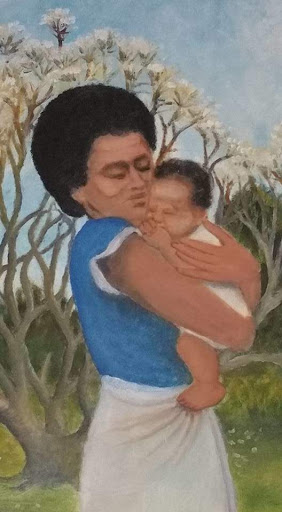Heroic Fiji artist Semisi Maya: post script
I was overwhelmed by readers' responses to my Semisi Maya post in 2021. What a thrill to learn some of you who had worked or holidayed in Fiji during Maya's lifetime had bought his paintings and still treasured them. An even greater thrill was that you took the trouble to tell me your stories and even to send photographs of your Maya works. In my replies, I promised I'd share the pics on the blog and with the Fiji Fan Club. Two years later, I've just discovered I can insert a whole gallery in a post so now it's time to keep my promise. For newer readers who missed the original post, I've included it below the gallery so you can read about Semisi Maya's heroic life and watch a video where he demonstrates his techniques.
The timber-framed landscape top-right was one of Maya's first paintings. Sanjay Ramrakha, whose father was a doctor who looked after the artist in the early 1960s, sent me this photo. Clearly, Maya had yet to develop his distinctive style using his hands, knuckles, and arms. Many thanks to Sanjay and to Lee Couillard, Andrew Green, Howard Eslien and Wannee Kertbundit for sharing pictures and stories. If I've missed anyone, I'm just as grateful to you, too.
To expand, click on a picture and use the slider arrows to view the whole gallery.
Semisi Maya: heroic Fiji artist
(first posted June 2021)
I regret I've only recently discovered Semisi Maya. When researching my fifth Fiji Islands Mystery, I came across St Elizabeth's Home in Suva and couldn't resist a quick check. Some of the links were for Semisi Maya. the first Fijian artist to find international recognition. He lived for many years at St Elizabeth's, then a rehabilitation home for former leprosy sufferers. It was there Semisi learned to paint.
It took him five years developing a technique before he painted a picture he was happy with. Unable to hold a brush, he used his severely deformed hands, knuckles, wrists and forearms to produce hundreds of watercolours: idyllic Fiji landscapes, village scenes and startling underwater seascapes which were his unique artistic vision. In a Fiji Times interview in 1982, Maya said, "These are my favourite subjects. All the men and children would go together at low tide and chase the fish with coconut leaves. Then we would take the spears and dive and look for fish... I remember it all very clearly."
Watch this brief video clip where Maya demonstrates his technique. (Pacific Leprosy Foundation)

Solo show in London gallery
It was best-selling thriller writer Dennis Wheatley who introduced Maya to the world. By the 1960s, Maya's paintings sold readily to tourists in Suva. Wheatley visited Suva and St Elizabeth's in 1966 and fell in love with Maya's style, buying several paintings.. Within a few months he arranged an exhibition of 80 Maya paintings at a Bond Street, London gallery. Gallery director James Green said "I'm quite convinced that the man who painted these is nothing short of genius." (Pacific Islands Monthly, 1978). Maya's paintings continued to sell strongly internationally until his death.
I found only a few examples of Maya's paintings on the internet. However, you may be a more skilled searcher and have more success. Please let me know if you do, as I'd love to see more.

Semisi Maya's life
Born on the chiefly island of Bau in 1927, Semisi went to school and learned a man's skills of fishing and growing crops. When he was about 20, leprosy struck, attacking the nerves of his hands and feet. He was devastated he could no longer be of any use to his village and sought treatment at the leprosarium on Makogai Island. His depression continued as he was too ill to take part in the sports, fishing and pastimes many of the patients enjoyed.
But after 14 years, and the advent of effective drugs, Semisi was cured of leprosy. He left Makogai, but spent time at St Elizabeth's (run by the Society of Mary) and the P.J. Twomey hospital in Suva for rehabilitation. Feeling useless, and desperate to find a worthwhile occupation, he took up an American nun's suggestion that he might be able to paint, if he worked very hard at it. She mixed paint with starch and coached him, hoping painting would be therapeutic for him. None could be more surprised and delighted than the nuns when they realised that Semisi was a true artist who had developed his powerful style over years of painful persistence. He decided to live permanently at St Elizabeth's, where he could earn his place with the sale of his paintings. Yet it was his happy memories of his island village youth that remained his inspiration.

Celebrated on postage stamps
The Fiji Post Office wisely chose Semisi Maya's art for stamps to mark the closing of the leprosy hospital on Makogai Island in 1970 and later, for The International Year of Disabled Persons in 1981. Indeed, it would be hard to find a more heroic and humble artist.

P.S. I love to answer any questions about Fiji or my books from readers. Just leave a comment below, send me a message via the Contact page or email me at bernadette@bmallsopp.com. I warmly invite you to join our Fiji Fan Club below.
If you have friends interested in Fiji or Pacific islands in general, I encourage you to share this post.
I look forward to hearing from you!
Bernadette
B.M. Allsopp

.png)


























So talented and the fact that he could paint just using his elbows, arms and knuckles. It must have been painful for him yet he persevered. A good role model for me. Thanks Bernadette
Fascinating, Bernadette- what a truly inspirational man. Thanks for sharing. Megan